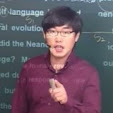All right, let’s start lesson no. 3. The third sentence structure is “저는 A이/가/께서 B하기를 원합니다/하면 좋겠습니다.”, which means “I want, or wish A to B(verb) ~”. 저는 is ‘I’, and the subject of the sentence. And the relation of A and B is nexus, which means A is the semantic subject of the verb, B. And the postposition, 이, 가, 께서 should be place behind A. 이 and 가 are the general form, and 께서 is an honorific form.
하기 behind B is the noun form of the verb, B, and 를 is the objective case, so B하기를 is the object of the verb, 원합니다, which means ‘to want’.
And 하면 좋겠습니다 is the same as “I wish blablabla”
OK, the schematic diagram is as follows.
저는 당신이 거기에 가기를 원합니다.
I want you to go there.
저는 is the subject of this sentence, and its meaning is ‘I’, and 당신 is ‘you’, and 이 is the subjective case. And 거기에 is an adverb, which means ‘there’, and 가기를 came from 가다, which means ‘to go’. If we replace the letter 다 with 기, then we make the verb a noun form. And 를 behind 가기 is the objective case, so 가기를 is the object of the verb, 원합니다, which means ‘to want’. So, 저는 당신이 거기에 가기를 원합니다.
I want you to go there.
2. 저는 그녀가 그 파티에 가지 않기를 원합니다.
I want her not to go to the party.
그녀 is ‘she’, and 가 is the subjective case, but as you know this 그녀가 is actually used as an object of the verb, ‘want’ in English sentence. 그 is ‘the’, and 파티 is written as it sounds. And 에 is the same as ‘to’. 가지 않기 came from two words, 가다 and 않다. If we combine these two words, 가다 and 않다 is changed into 가지않다, which means ‘not to go’, and 를 is the objective case. And 원합니다 is ‘to want’. So, 저는 그녀가 그 파티에 가지 않기를 원합니다.
I want her not to go to the party.
3. 저는 저의 아들이 운동하기를 원합니다.
I want my son to work out.
저의 is ‘my’, and 아들 is ‘son', and 이 is the subjective case. And 운동하기 is the noun form of 운동하다, which means ‘to work out, or exercise'. All the verbs in Korean language end with the letter, 다, and if we replace 다 with 기, the verb is changed into a noun. And 를 is the objective case. And 원합니다 is ‘to want’, so 저는 저의 아들이 운동하기를 원합니다.
I want my son to work out.
4. 저는 그녀가 저를 마음에 들어하면 좋겠습니다.
I wish her to like me.
그녀가 is ‘she’, and 저를 is ‘me', and 마음에 들어하다 is the same as ‘to like’. In fact, 마음 is ‘mind’, but ‘마음에 들다’, or ‘마음에 들어하다’ is ‘to like’. And 좋겠습니다 is ‘to wish’.
So, 저는 그녀가 저를 마음에 들어하면 좋겠습니다.
I wish her to like me.
5. 저는 그 회사가 저를 채용하면 좋겠습니다.
I wish the company to hire me.
그 is ‘the’, and 회사 is ‘company’, and 가 is the subjective case. 저 is ‘I’, and 를 is the objective case, so 저를 is ‘me’, right? And 채용하면 came from 채용하다, which means ‘to hire’.
So, 저는 그 회사가 저를 채용하면 좋겠습니다.
I wish the company to hire me.







0 Comments